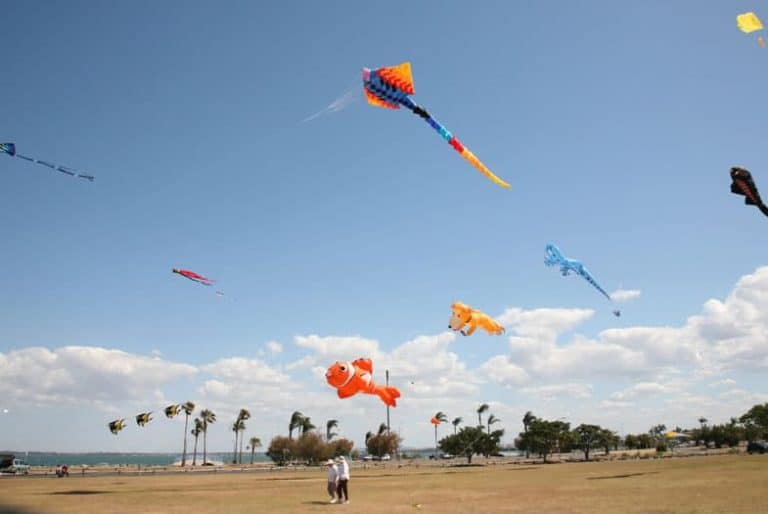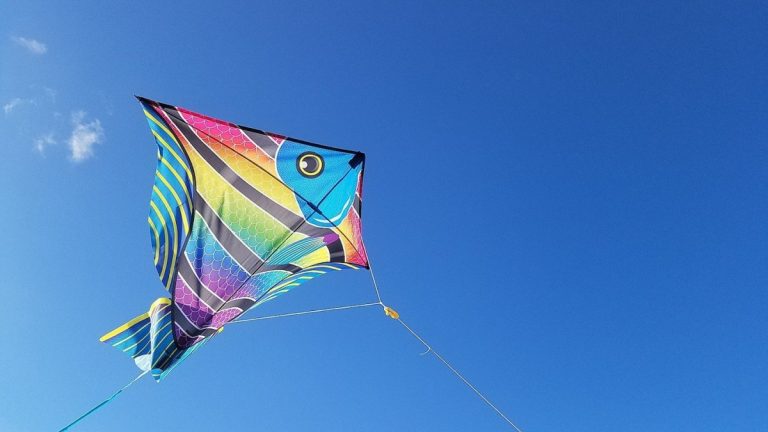Can You Fly A Kite Without Wind?
Kite flying is a centuries-old outdoor activity that is enjoyed by young and old alike and in all parts of the world. We all know that the best conditions for flying a kite are on days where the wind is blowing, or at least where there is a bit of a breeze. But why is the wind necessary for flying kites, and is it possible to fly a kite without wind?
It is impossible to fly a kite with no wind at all. The kite needs airflow to generate lift and cause the kite to stay airborne. If there is no wind blowing at ground level, the kite flyer may need to provide the forward motion to get the kite to climb to a level where the wind is blowing.
If you have planned to enjoy a day out flying kites in the park on the weekend and you have planned the outing, but when the day arrives, there is no wind, what do you do? Is it possible to fly a kite with no wind? Another question that could be asked is how much wind is actually needed to fly a kite? You may be able to get your kite airborne, even on still days, with an appropriately executed technique.
Can You Fly A Kite Without Wind?
The way that kites fly relies on the balancing of the same forces; weight, lift, thrust and drag, which affect the way aircraft fly. When these forces are all balanced correctly, the kite will fly and stay aloft for the duration that all the forces are in play and one does not overpower the other.
The Force Of Lift In Kite Flying
In kite flying, the lift force, which is what lifts the kite into the air, is generated by a difference in air pressure, which is affected by the shape of the kite and air that is in motion around the kite. The shape of the kite is designed to make the air moving over the top of the kite faster than the air moving below the kite.
This forms a low pressure at the back of the kite and a high pressure underneath or on the string side of the kite. The high pressure under the kite pushes the kite towards the low-pressure area, which creates lift.
The negative force that the force of lift needs to overcome to get the kite to take off and remain in the sky is the force of weight. This is a combination of the weight of the kite and the action of the earth’s gravity on that weight.
The force of lift must overcome the weight of the kite and the force of gravity that is pulling the weight back to the earth.
The Force Of Thrust in Kite Flying
Thrust is the force that is necessary to create lift but is also needed to overcome drag. Drag is the force in play that slows down the flow of air over the kite and operates in the opposite direction to the thrust. Drag is the result of the difference in air pressure between the front and back of the kite and friction of the air moving over the surface of the kite.
In order for this principle of lift to work and to overcome the effects of drag, the kite needs air to flow over it. Aircraft produce this force called thrust, which moves the aircraft forward to create the airflow over the wing of the aircraft. Kites do not have this forward motion or thrust to generate air movement over the structure of the kite.
Thus, the kite relies on the motion of the air itself, the wind, to flow over it and produce the necessary high and low-pressure conditions that produce lift.
How Much Wind Is Necessary To Fly A Kite?
The amount of wind that you need to get a kite airborne will depend on a few factors relating to the construction of your kite.
The two main factors that will affect your kite’s ability to get airborne in as little wind as possible will be the size of the kite and the weight of the kite.
Kites that are large but very light will be able to catch the slightest breeze and get airborne. This is because the larger surface area of the kite will catch more wind, and because the kite is light, it will lift into the air easily.
The converse is also true kites that have a small surface area and that are heavy may even struggle to lift off even in a stiff breeze. The ratio of the kite’s weight to surface area is, therefore, a crucial characteristic of the kite that will affect how easy it is to fly in very little wind.
Modern kite construction takes these factors into account, and with the availability of new lightweight materials, most kites on the market today will fly with very little wind.
A light wind of between 4 to 10mph is probably sufficient to get most kites off the ground and flying high. You can take a look at the surrounding environment to determine the wind, and the general rule is that if you can feel the breeze on your face, then there is probably enough wind to fly your kite.
You can also take a look at flags, rustling leaves on the ground, the wind moving the grass, or paper being moved by the wind. All these indicators will give you a good idea if the wind is strong enough to fly a kite.
How To Get Your Kite Flying in No Wind
There are few circumstances where there is no wind at all in the atmosphere. Even when there is no wind at ground level, there is usually some movement of the air or wind at higher levels. The trick is to get your kite to the level in the sky where there is enough wind to keep the kite aloft.
Provide Your Own Forward Motion
One method of getting your kite airborne and generate the necessary airflow over the kite is for you, the kite flyer, to provide the airflow by forward motion.
This will involve running while towing the kite behind you to generate forward motion for the kite to produce enough lift to get the kite into the air.
You would need to have enough space to run far enough to get the kite high enough that it catches any breeze or wind that is moving in the higher air spaces.
This method will only be successful if there is moving air in the atmosphere at around treetop height. It will be difficult to get the kite higher than this by running and towing the kite behind you. The main disadvantage to this kite launching strategy is that it requires a lot of space for you to run, and it can be very tiring, depending on your physical condition or fitness.
Provide Your Own Lift For The Kite
This method can take several forms, and the success of the strategy will depend on how much wind is available.
- Long launch. The long launch involves letting a good amount of line out and getting a friend to hold the kite some distance from you. Get your friend to throw the kite into the air, and as he does this, tug on the line to produce forward motion of the kite and, thus, airflow. With a little practice and luck, the kite will launch and catch a breeze a little higher in the air and take off.
- Use a fishing rod. Use a fishing rod and reel to spool out and retrieve the kite line. Lay the kite on the ground and spool out some line as you walk backward. Once you have about 20ft of line spooled out, reduce the drag on the reel. With the line taut, pull the tip of the fishing rod up, which should launch the kite off the ground. Keep dropping the tip of the rod and lifting it up to make the line tight and create airflow over the kite. You may need to reel in a little line if it becomes too slack. When the kite takes off, release the drag on the line and allow it to spool out to the height that you want to fly, then lock the drag down again.
- Use balloons. Some people use helium-filled balloons to get their kites airborne to the point where the air wind will be blowing at higher altitudes. While this method does work, it does limit the amount you can do with the kite since the balloon is attached to the kite for the duration of the flight, unless you can figure out a way to release it once altitude is reached.
Conclusion
Basically, kites need wind to fly. If there is no wind movement at ground level, you will need to provide the necessary forward motion of the kite to produce the airflow required to generate the lift and get the kite to a higher altitude where there is some airflow.
If it is a very calm day and there is very little air movement, even at higher altitudes, then you will struggle to get your kite aloft and keep it flying.
If you are struggling to get your kite in the air, it may be better to avoid the frustration, pack up your kite, and try again on another day where the wind is more conducive to kite flying!







